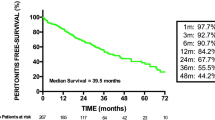Abstract
Purpose
Prevalence of peritoneal dialysis is low in part because of the perceived high risk for complications such as peritonitis. However, in the most recent era, peritonitis incidence and its effects on patient outcomes may have diminished. The aim of this study was to analyze peritonitis incidence and its impact on patient and technique survival, as well as on the kidney transplantation rate and outcome.
Methods
All peritoneal dialysis patients from a county hospital between year 2001 and 2011 were retrospectively included. Patients were divided into two groups with respect to peritonitis. The primary composite end-point consisted of a 3-year patient mortality or technique loss. Secondary end-points were patient survival and probability of kidney transplantation with respect to peritonitis history.
Results
Among 85 study patients, there were 61 peritonitis episodes. The incidence of peritonitis was 0.339 ± 0.71 episode per patient per 12 months or one episode per 29.3 ± 22.2 patient-months. The time to peritonitis was shorter, and peritonitis was more likely in patients on continuous ambulatory peritoneal dialysis than in automated peritoneal dialysis patients. Patient and technique survival and transplantation rate were similar in the group with and without peritonitis history. The primary end-point was recorded in 35 % of patients with peritonitis history and in 54 % of those without peritonitis (p = 0.04). In a multivariate analysis, the only variable significantly associated with the primary end-point and with patient survival was patient age at start of peritoneal dialysis.
Conclusions
In contemporary peritoneal dialysis patients, timely treated peritonitis may not be associated with adverse patient and technique outcomes. The transplantation rate is unaffected by the peritonitis history. Peritoneal dialysis may be promoted as the first dialysis method in appropriate patients.




Similar content being viewed by others
References
Lameire N, Van BW (2010) Epidemiology of peritoneal dialysis: a story of believers and nonbelievers. Nat Rev Nephrol 6:75–82
Chaudhary K, Sangha H, Khanna R (2011) Peritoneal dialysis first: rationale. Clin J Am Soc Nephrol 6:447–456
Cala S (2007) Peritoneal dialysis in Croatia. Perit Dial Int 27:238–244
Burkart J (2009) The future of peritoneal dialysis in the United States: optimizing its use. Clin J Am Soc Nephrol l4(Suppl 1):S125–S131
Huang ST, Chuang YW, Cheng CH, Wu MJ, Chen CH, Yu TM et al (2011) Evolution of microbiological trends and treatment outcomes in peritoneal dialysis-related peritonitis. Clin Nephrol 75:416–425
Li PK, Szeto CC (2008) Success of the peritoneal dialysis programme in Hong Kong. Nephrol Dial Transplant 23:1475–1478
Lim W, Dogra G, McDonald SP, Brown FG, Johnson DW (2011) Compared with younger peritoneal dialysis patients, elderly patients have similar peritonitis-free survival and lower risk of technique failure, but higher risk of peritonitis-related mortality. Perit Dial Int 31:663–671
Brown M, Simpson K, Kerssens JJ, Mactier R (2011) Peritoneal dialysis-associated peritonitis rates and outcomes in a national cohort are not improving in the post-millennium (2000–2007). Perit Dial Int 31:639–650
Davenport A (2009) Peritonitis remains the major clinical complication of peritoneal dialysis: the London, UK, peritonitis audit 2002–2003. Perit Dial Int 29:297–302
Li PK, Szeto CC, Piraino B, Bernardini J, Figueiredo AE, Gupta A et al (2010) Peritoneal dialysis-related infections recommendations: 2010 update. Perit Dial Int 30:393–423
Munoz de Bustillo E, Borras F, Gomez-Roldan C, Perez-Contreras FJ, Olivares J et al (2011) Impact of peritonitis on long-term survival of peritoneal dialysis patients. Nefrologia 31:723–732
Oliveira LG, Luengo J, Caramori JC, Montelli AC, Cunha MD, Barretti P (2012) Peritonitis in recent years: clinical findings and predictors of treatment response of 170 episodes at a single Brazilian center. Int Urol Nephrol [EPub ahead of print]
Rabindranath KS, Adams J, Ali TZ, Daly C, Vale L, Macleod AM (2007) Automated vs continuous ambulatory peritoneal dialysis: a systematic review of randomized controlled trials. Nephrol Dial Transplant 22:2991–2998
Balasubramanian G, McKitty K, Fan SL (2011) Comparing automated peritoneal dialysis with continuous ambulatory peritoneal dialysis: survival and quality of life differences? Nephrol Dial Transplant 26:1702–1728
Szeto CC, Kwan BC, Chow KM, Law MC, Pang WF, Leung CB et al (2011) Repeat peritonitis in peritoneal dialysis: retrospective review of 181 consecutive cases. Clin J Am Soc Nephrol 6:827–833
Croatian Renal Replacement Therapy Registry on 31. 12. 2010; www.hdndt.org. Accessed on 16-06-2012
Caliskan Y, Yazici H, Gorgulu N, Yelken B, Emre T, Turkmen A et al (2009) Effect of pre-transplant dialysis modality on kidney transplantation outcome. Perit Dial Int 29(Suppl 2):S117–S122
Joseph JT, Jindal RM (2002) Influence of dialysis on post-transplant events. Clin Transplant 16:18–23
Goldfarb-Rumyantzev AS, Hurdle JF, Scandling JD, Baird BC, Cheung AK (2005) The role of pretransplantation renal replacement therapy modality in kidney allograft and recipient survival. Am J Kidney Dis 46:537–549
Annual Report 2010. Eurotransplant. www.eurotransplant.org. Accessed on 1-12-2011
Author information
Authors and Affiliations
Corresponding author
Rights and permissions
About this article
Cite this article
Klarić, D., Knotek, M. Long-term effects of peritonitis on peritoneal dialysis outcomes. Int Urol Nephrol 45, 519–525 (2013). https://doi.org/10.1007/s11255-012-0257-2
Received:
Accepted:
Published:
Issue Date:
DOI: https://doi.org/10.1007/s11255-012-0257-2




